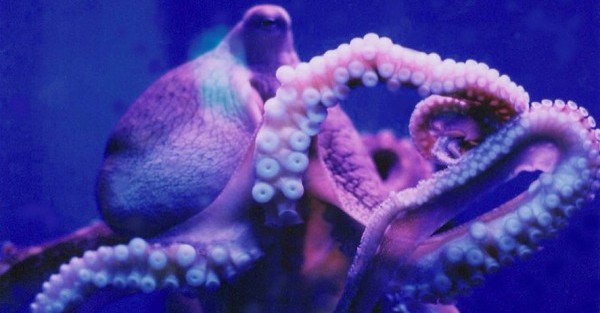
Darwin concludes his great book by noting that life on earth began with only a few forms or even with just one form. He marvels that “from so simple a beginning endless forms most beautiful and most wonderful have been, and are being, evolved.”
The Giant Pacific Octopus (Enteroctopus dofleini) is a seemingly endless form all by itself. It is a form most beautiful, or at any rate, most strange. Orange. Its eight rather alarming arms twine about the rest of it, making it difficult to discern where one arm ends and another begins. A certain obscurity, then. The eyes, though, are not obscure. The octopus I’m staring at, Homer, a 40-pound occupant of the Seattle Aquarium, is staring back at me. Homer’s gaze is piercing, observant. Octopuses are intelligent. They can recognize faces, including each keeper and various visitors. If they don’t like you, they ink you.
The strangeness is in the arms. In a book titled Octopus, M. J. Wells writes, “The layman’s octopus is an animal that consists of arms. In amongst the arms, somewhere in the middle, is a head with almost human eyes.” Lining the underside of each arm are two rows of white suction-cup-type suckers, about 280 on each arm—that’s 2,240 suckers. The suckers become progressively smaller as the arms narrow to armtips.
Now Homer has stuck himself on the side of the aquarium wall, white suckers facing out. From this vantage point, he appears to be nothing but arms, endless curving rows of white suckers. Ah, I now understand the source of the art movement known as Pattern and Decoration.
But Homer’s love interest, residing in the adjacent aquarium and just now ignoring him, looks more like a rock deposited on the seafloor. No suckers visible.
The suckers are sense organs. They taste and they smell. They have 350 million neurons, as many as are in the octopus brain.
So there you have it. Intelligence but no bones. Brains but no spine. Jointless. A bag for a body, plus arms. Plus those intelligent eyes. The mouth is located at the center of the arms, at the bottom, way in there—you can’t see it. It takes the form of a hard beak and a hard “tongue” (radula), good for crunching Dungeness crab.
Pigment is part of it. Frightened, the octopus goes white. When hunting or sleeping, it replicates rocks, its seabottom rubble. Octopus skin contains chromatophores, tiny bags of pigment, and reflecting elements contribute to the creature’s ability to camouflage. If you are a seal or a shark or a fisherman looking for dinner, you might just overlook it.
This “devil fish,” as sailors used to call it, has venom bad as a bee sting and jet propulsion (it shoots water out of its siphons). When speeding along with arms streaming behind, the devil fish looks like a squid. Both are cephalopods, a class of the phylum Mollusca.
Except for mating, which it does once in a lifetime, the octopus is a solitary being. It dwells in underwater caves or rock piles. It lives four or five years.
Back to our own kind. At times when traffic, concrete, car horns, computer dings—our hyper-stimulated, stressed-out life—become altogether too much, I recommend an extended visit with some other species. Consider, then, the octopus—that endless form most beautiful.

